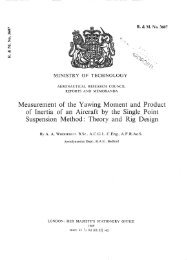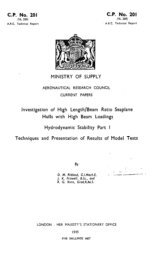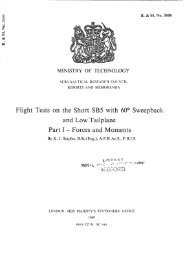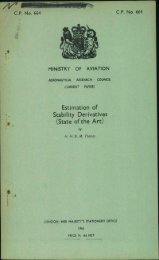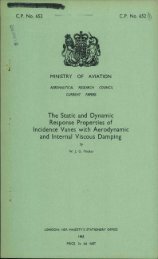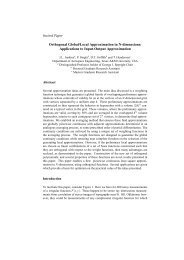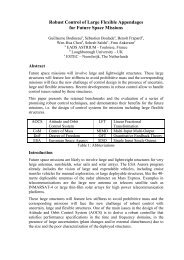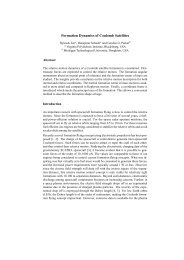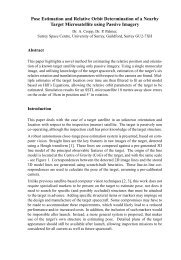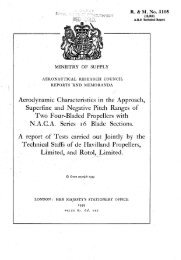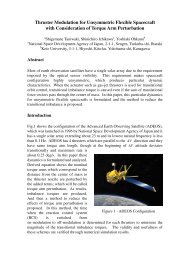The Aerodynamic Characteristics of Flaps
The Aerodynamic Characteristics of Flaps
The Aerodynamic Characteristics of Flaps
You also want an ePaper? Increase the reach of your titles
YUMPU automatically turns print PDFs into web optimized ePapers that Google loves.
<strong>The</strong> effectiveness <strong>of</strong> the flap derives from the fact that on rotation it changes the camber <strong>of</strong><br />
the section and so permits <strong>of</strong> a change <strong>of</strong> circulation and therefore, <strong>of</strong> lift at a given incidence.<br />
<strong>The</strong> change in chordwise loading produced by. a positive setting <strong>of</strong> the flap is <strong>of</strong> the type illustrated<br />
in Fig. 2b, having a maximum near the wing leading edge and a secondary peak at the flap<br />
hinge but falling to zero at the flap trailing edge 29.<br />
2.2. Split <strong>Flaps</strong>.--<strong>The</strong> term spl!t flap is normally understood to mean a flap that is formed<br />
by splitting the wing trailing edge m a roughly chordwise direction back to a hing.e,, about which<br />
the lower portion <strong>of</strong> the Wing trailing edge can rotate, the upper portion remammg fixed (see<br />
Fig. lb). <strong>The</strong> definition has tended to become generalised to cover any flap that is hinged on or<br />
in contact with the wing under surface and whose operation does not alter the wing upper surface.<br />
Thus split flaps may lie forward <strong>of</strong> the trailing-edge position, 'as is frequently required for<br />
dive brakes or flaps on sweptback wings, or their line <strong>of</strong> contact with the wing may slide back as<br />
they open, as for Zap-type flaps (see Fig. lb). Unless otherwise stated, however, when reference<br />
is made to split flaps in this report, the simple trailing-edge type will be understood.<br />
Split flaps boost the circulation when operated, by increasing the suction behind them and<br />
therefore at the wing trailing edge, and alleviating the adverse pressure gradient on the wing<br />
upper surface. <strong>The</strong> resulting change in the chordwise loading distribution is not unlike that for<br />
plain flaps except for the discontinuity in pressure across the split flap and a rather greater suction<br />
at the trailing edge.<br />
2.3. Slotted <strong>Flaps</strong>.--When a portion <strong>of</strong> the rear <strong>of</strong> a wing can be rotated to leave a well-defined<br />
slot between it and the rest <strong>of</strong> the wing, then it is referred to as a slotted flap. It nlay be simply<br />
hinged just below its nose, as in the case <strong>of</strong> the Handley Page type <strong>of</strong> slotted flap (see Fig. lc)<br />
or it may be operated with a link or track mechanism, as in the case <strong>of</strong> the N.A.C.A. (Fig. ld),<br />
Blackburn (Fig. le) and Fowler (Fig. If, lg) types <strong>of</strong> flaps. All slotted flaps have a certain amount<br />
<strong>of</strong> backward movement when operated.<br />
<strong>The</strong> lift increments <strong>of</strong> slotted flaps result from three main factors. <strong>The</strong> first is the effective<br />
change <strong>of</strong> camber produced by setting down the flap, as with plain flaps. <strong>The</strong> second is due to<br />
the flow through the slot re-energising the boundary layer, when the slot is well designed, and so<br />
delaying flow separation from the flap. <strong>The</strong> third is the increase <strong>of</strong> effective lifting surface due<br />
to the rearward movement <strong>of</strong> the flap. In the case <strong>of</strong> the simple Handley Page type <strong>of</strong> flap,<br />
the hinge is not very much below the flap nose and the rearward extension is small, the contribution<br />
to the lift increment associated with this extension is then comparatively unimportant.<br />
On the other hand, in the case <strong>of</strong> the Fowler flap, the rearward extension is considerable, being<br />
about the length <strong>of</strong> the flap chord, and the corresponding contribution to the lift increment is<br />
very important. <strong>The</strong> Blackburn type <strong>of</strong> flap is, in this respect, half way between the Handley<br />
Page and Fowler types <strong>of</strong> flap. It moves about an effective hinge centre set well below the flap<br />
nose, and when fully extended provides a considerable extension <strong>of</strong> lifting area.<br />
As noted above, the effect <strong>of</strong> the slot in helping to delay flow separation from the flap and so<br />
boosting circulation depends very critically on the design <strong>of</strong> the slot. Details <strong>of</strong> efficient slot<br />
designs cannot be given here ; they are to a considerable extent a function <strong>of</strong> the wing section<br />
and flap angle, and reference should be made to the separate reports giving the results <strong>of</strong> tests<br />
<strong>of</strong> different slot shapes (see, for example, Refs. 54 to 57, 60, 62, 63, 66 to 70, 74, 76 to 78). <strong>The</strong><br />
more important dimensions that have been found to lead to successful slot shapes are indicated<br />
in Fig. 1. All that can be said here is that breakaway in the slot must be avoided, and so the<br />
slot must converge steadily from the lower to the upper surface. Further, the flow from the<br />
slot must merge smoothly into the flow round the wing and flap ; hence, an appreciable length<br />
<strong>of</strong> lip or shroud to the upper surface <strong>of</strong> the slot is an advantage. In general, it should be possible<br />
to fit a smooth curve connecting the wing and flap contours.<br />
It is important to realise that if the slot is not efficient it may be worse than no slot at all,<br />
as the flow through it may then stimulate rather than suppress flow breakaway over the flap.<br />
It is this tendency <strong>of</strong> a well-designed slot to suppress flow breakaway over the flap that gives the<br />
slotted flap its characteristic <strong>of</strong> low drag at small or moderate flap angles.<br />
5



